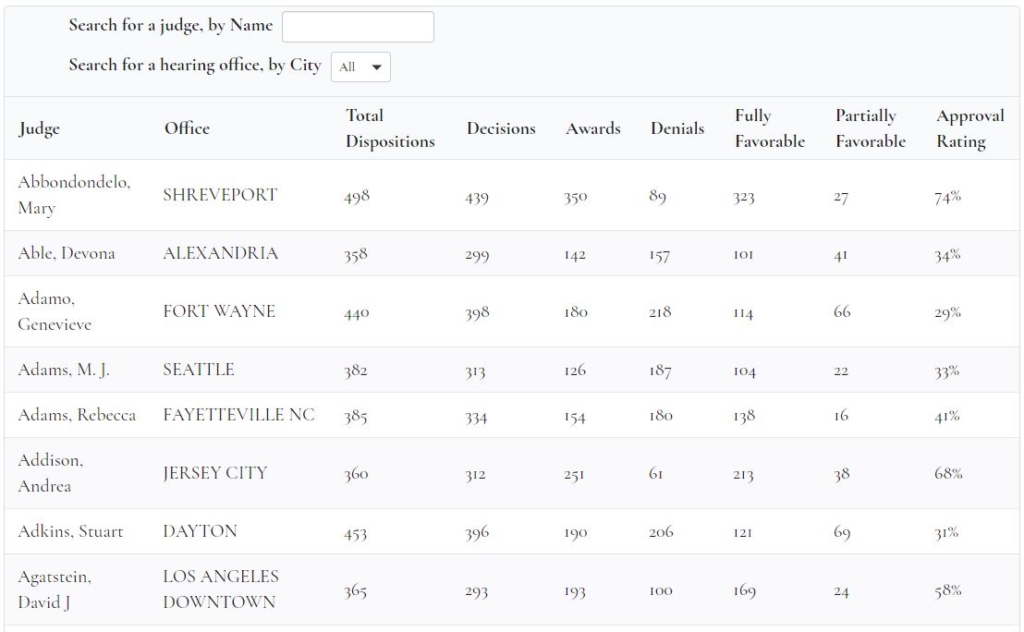We recently added to our website a very helpful section entitled Judge Search – https://www.thegoodlawgroup.com/judge-search/. The purpose of this is to give the public and our clients the ability to find out what percentage of time the Judge who presides over the Social Security hearing finds either partially or fully for the claimant. Please realize that the Judges have quotas of cases they must complete in a year. You should also understand that the Judges are bound by the Social Security rules. Some Judges are fair and honest, and some judges are not. You are really just hoping for a fair judge.
The main reason to search your judge is to see what percentage of the time your judge issues favorable decisions. The current national average for favorable decisions is 44%.
At the top of the page there are two search boxes. One for the judge’s name and the other one for the city the hearing office is in.
This page has 9 columns.
The first column has the Judges first and last name. There are about 1500 Judges. There are many judges with the same or similar names.
The second column tell what city they are in. So you must check and make sure that you have the correct name and city, before you look at the Judges statistics.
The third column entitled Total Dispositions, tells the number of dispositions so far that year. Our website updates every month. It is based on the data that the Social Security Administration publishes. If it is early in the year and a judge has only had 10 dispositions the percentages may be skewed because there is not a big enough sample size to accurately reflect the judge’s percentage. Total dispositions include all types of decisions including dismissals, like if somebody doesn’t show up for court or they missed a deadline.
The fourth column entitled Decisions, gives the number of written decisions the Judge has issued so far that year.
The fifth column is entitled Awards. The column is a combination of Full Favorable decisions column 6 and Partially Favorable decisions column 7. A Fully Favorable decision means the Judge found in Favor of the claimant on all issues. This number can be fudged by the judge by offering to issue a Fully Favorable decision if you change your onset of disability date or agree to a closed period at the hearing. This tends to make the judge look better to the public. One of the problems with this is that if a Judge offers to issue a Fully Favorable decision at the hearing and the claimant does not take it. The judge can then either issue a Partially Favorable decision or deny the claimant entirely.
There is no advantage to not accepting an offer of a Fully Favorable decision because the Judges have to write a decision whether they give you a Fully Favorable decision, partially favorable decision or deny your claim. While it is still on the books, almost no Judges issue decision from the bench anymore. This used to be an advantage to accepting a Fully Favorable decision, because you would get the decision that day, and the written decision would come out in a week instead of a month to 3 months. We wish they still did this, it would help a lot of our clients because they would receive there benefits much quicker.
The sixth column entitled Denials, represents the number of cases the judge issued decisions where they denied the claimant’s entire claim.
The seventh column entitled Fully Favorable decisions provides the number of Fully Favorable decisions where the judge issued Fully Favorable decisions for the claimant.
The eighth columns entitled Partially Favorable decisions, gives the number of decisions where the judge awarded part of what the claimant was asking for. This could mean, they only paid the claimant for part of the time they wanted, this is called a closed period. Another type of Partially Favorable decision is when the Judge decides the onset of the disability is not what the claimant requested. So for example if the claimant said he became disabled in January of 2019 and the judge decided the claimant was disabled from the date of the hearing on. There are some judges who do this routinely. This allows them to deprive the claimant out of their back pay and can also deprive the attorney from getting paid out of the back pay.
To learn more about both types of partially favorable decisions, watch this short video.
The ninth column is the approval rating column. This really is the only way that one can compare judges. Approval rating is the percentage of the number of Fully Favorable decisions (column 7) of the total Decisions (column 3). The higher the percentage the better.
When you search the city where the hearing office is, you can compare what the other judges do. There is a big difference in the judges who are around the 44 percent number and even 10 percent less. Remember the Judges all work for the Social Security administration. They have never fired a judge having too low of a percentage of Fully Favorable decisions.
The Good Law Group










